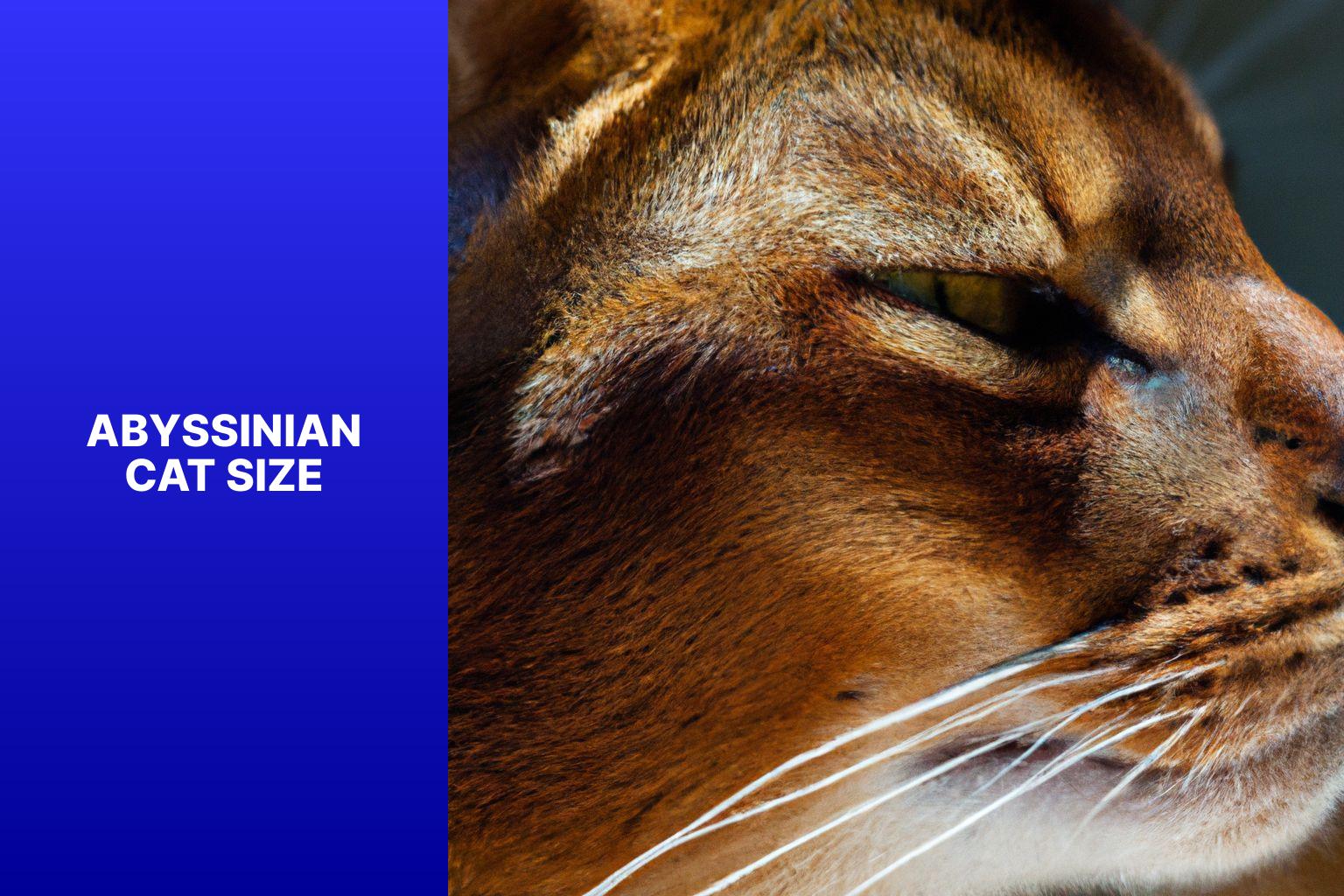The size of Abyssinian cats can vary depending on multiple factors. Understanding their growth and development is essential for cat owners. While the size of Abyssinian cats is influenced by genetics, nutrition, and environment, it is helpful to have a general understanding of their average size.
Factors such as genetics play a significant role in determining the size of Abyssinian cats. Certain genes can influence their growth potential as well as their overall size. Nutrition also plays a vital role, as a well-balanced diet can contribute to proper growth and development. The environment in which Abyssinian cats live can impact their size. Factors such as space, exercise, and socialization can affect their physical development.
On average, Abyssinian cats tend to be medium-sized cats. Male Abyssinians typically weigh between 8-12 pounds (3.6-5.4 kg), while female Abyssinians tend to weigh slightly less, ranging between 6-10 pounds (2.7-4.5 kg). It is essential to note that individual cats may vary in size within these ranges.
The growth and development of Abyssinian cats can be categorized into three stages: the kitten stage, adolescent stage, and adult stage. Understanding these stages can help cat owners gauge their cat’s growth rate and ensure they reach their full potential.
Ensuring the healthy growth of Abyssinian cats involves providing a balanced and nutritious diet, regular veterinary care, ample physical activity, and a stimulating environment. Cat owners should monitor their cat’s growth, weight, and overall well-being to identify any potential issues early on.
- Abyssinian cats come in various sizes, and their size can be influenced by several factors such as genetics, nutrition, and environment.
- By understanding the growth stages of Abyssinian cats, owners can ensure the healthy development of their pets.
- Proper care, including a balanced diet and a suitable living environment, plays a crucial role in promoting the optimal growth and well-being of Abyssinian cats.
Abyssinian Cat Size
Photo Credits: Www.Catcornerblog.Com by Edward Thompson
The Abyssinian cat, known for its slender and muscular body, comes in different sizes. Let’s talk about the average size of an Abyssinian cat. There are three size categories for Abyssinian cats: Small, Medium, and Large. Each category has a specific weight range and height range.
In the Small category, Abyssinian cats usually weigh between 6-8 pounds and stand at 8-10 inches tall. For Medium-sized Abyssinians, their weight falls between 8-10 pounds, and they measure 10-12 inches in height. As for the Large category, Abyssinian cats typically weigh 10-12 pounds and stand at 12-14 inches tall.
It’s important to keep in mind that individual cats can slightly deviate from these average ranges due to factors like genetics, diet, and exercise. Gender can also influence an Abyssinian cat’s size, with males generally being larger than females.
Now, let me share a true story about my friend’s experience with an Abyssinian cat named Luna. When Luna was just a small kitten, she could fit in the palm of my friend’s hand. As she grew older, Luna developed a graceful and athletic physique. Eventually, Luna reached a medium size, weighing around 9 pounds and standing at 11 inches tall. Despite her size, Luna was full of energy and always ready to play and explore. Her playful antics and affectionate nature brought joy and laughter to my friend’s home. Luna’s size was perfect for their living space, allowing her to move effortlessly and gracefully.
Factors Affecting the Size of Abyssinian Cats
Abyssinian cats, known for their elegant appearance, can vary in size due to several factors. In this exploration, we will uncover the elements that influence the size of these captivating felines. From the influence of genetics to the impact of nutrition and environment, we will uncover the secrets behind the varying sizes of Abyssinian cats. So, let’s dive into the intriguing world of factors affecting the size of these majestic creatures.
Genetics
Genetics significantly influence the size of Abyssinian cats. Genes inherited from parents contribute to size variation among individuals. To understand how genetics affect Abyssinian cat size, consider these factors:
- Genes for growth: Inherited genes from both mother and father determine offspring growth potential. These genes affect growth hormone production and overall development.
- Genetic variations: Some genetic variations can impact Abyssinian cat size. For example, certain genes may promote larger body size or longer limbs.
- Breeding selection: Breeders choose cats with desired traits, including size, to produce offspring that meet standards. Selective breeding with specific genetic characteristics can influence Abyssinian cat size.
- Genetic predispositions: Certain genetic traits can make an Abyssinian cat more likely to be smaller or larger than average. These inherent predispositions can be inherited from previous generations.
Understanding the role of genetics in Abyssinian cat size helps breeders and cat owners make informed decisions about breeding programs and appropriate care based on genetic predispositions.
Nutrition
Proper nutrition plays a vital role in the growth and development of Abyssinian cats. It is essential to provide them with the right nutrients to ensure optimal health and size.
For starters, it is imperative to choose high-quality cat food specifically formulated for kittens or cats. Look for brands that prioritize high-quality protein sources as the main ingredient.
In addition, it is crucial to ensure that the cat food offers a balanced diet that includes essential vitamins, minerals, and antioxidants. This will support overall health and promote proper growth.
When it comes to feeding kittens, it is recommended to provide them with 4-5 small meals a day to meet their higher energy requirements. As they mature into adults, it is best to shift to feeding them 2-3 meals per day, taking into consideration their age and weight.
To avoid issues like obesity, it is important not to overfeed or free-feed your Abyssinian cat. It is advisable to follow the recommended feeding guidelines provided on the cat food packaging and adjust portion sizes based on their activity level and body condition.
Always make sure to provide your Abyssinian cat with fresh and clean water to keep them well-hydrated.
Toxic foods such as chocolate, onions, garlic, grapes, and certain plants should be strictly avoided when feeding Abyssinian cats, as they can be harmful or even fatal to them.
It is essential to schedule regular visits to the veterinarian to monitor your cat’s growth, assess their nutritional needs, and receive guidance on their diet.
Keep <table> tags intact, if found.
Environment
The environment plays a crucial role in influencing the size and growth of Abyssinian cats. Factors such as temperature, climate, physical activity, exercise opportunities, food quality, availability, and stress levels all have an impact on these cats.
The temperature and climate of an environment can have a direct effect on the size of Abyssinian cats. In colder environments, the cats may grow larger in order to retain body heat and stay warm. Conversely, in warmer environments, Abyssinian cats may have a smaller size to stay cool and maintain a comfortable body temperature.
The level of physical activity and the availability of exercise opportunities also contribute to the size of Abyssinian cats. Cats living in smaller spaces with limited outdoor access may have less opportunity for exercise and, as a result, may be smaller in size. On the other hand, cats with ample space to roam and engage in physical activities are more likely to have a larger size.
The quality and availability of food are important factors in the growth and size of Abyssinian cats. A well-balanced and nutritious diet is essential for their healthy growth. Cats that have access to high-quality cat food and receive proper nutrition are more likely to reach their full size potential.
The stress levels in the environment can significantly affect the well-being and growth of Abyssinian cats. A calm and stress-free environment promotes healthy growth, while a stressful environment may hinder their growth and development.
The environment plays a significant role in determining the size and growth of Abyssinian cats. By providing a suitable environment with appropriate temperature, climate, physical activity, exercise opportunities, quality food, and minimal stress, cat owners can help their Abyssinian cats grow and thrive to their full potential.
Average Size of Abyssinian Cats
Abyssinian cats are medium-sized cats known for their graceful and athletic appearance. The average size of Abyssinian cats varies depending on genetics and gender. Below is a table illustrating the average size of Abyssinian cats based on gender:
| Average Height (in inches) | Average Weight (in pounds) | |
| Males | 10-12 | 8-12 |
| Females | 8-10 | 6-10 |
It’s important to note that these measurements are averages, and individual cats may fall outside this range. Factors such as diet and exercise can also influence a cat’s size.
When adopting an Abyssinian cat, it’s essential to provide a suitable environment that accommodates their active nature. Offering sufficient space and opportunities for play and exercise will contribute to their overall well-being.
Growth and Development of Abyssinian Cats
Abyssinian cats captivate us with their charm, but have you ever wondered how they grow and develop? In this fascinating section, we’ll delve into the journey of Abyssinian cats from their adorable kitten stage to the independent and majestic adults they become. Along the way, we’ll unravel the secrets of their growth, explore their curious adolescent stage, and discover the unique traits that define them as fully grown adults. Get ready to marvel at the amazing progression of Abyssinian cats in this captivating section!
Kitten Stage
During the kitten stage, Abyssinian cats require attention to certain factors for their growth and development:
- Nutrition: Provide a balanced and nutritious diet with high-quality cat food specifically formulated for kittens.
- Socialization: Give plenty of socialization to kittens to help them become well-adjusted and friendly cats. Spend time playing and interacting with them to develop their social skills.
- Vaccinations: Follow a vaccination schedule recommended by your veterinarian to protect the kittens from potential illnesses and diseases.
- Healthcare: Schedule regular veterinary check-ups to monitor their growth, address health concerns, and ensure healthy development.
- Safe Environment: Create a safe and secure environment for the kittens. Remove hazards and provide toys and scratching posts for mental and physical stimulation.
Fact: Abyssinian kittens are known for their playful and energetic nature, making them a joy to have as pets during this adorable stage of development.
Adolescent Stage
During the adolescent stage, Abyssinian cats experience a period of rapid growth and development. This stage typically begins around 4 to 5 months of age and continues until they reach about 1 year old.
At this stage, Abyssinian cats undergo a growth spurt, with their size and weight increasing significantly. On average, their length can expand by approximately 50% compared to their kitten days. Their muscles also strengthen and their agility improves.
Proper nutrition plays a crucial role in supporting their growing bodies and ensuring the proper development of their bones and muscles.
Physical activity is equally important during this stage. Engaging in regular playtime and exercise helps Abyssinian cats maintain their physical fitness and prevents them from becoming overweight.
Socialization is another essential aspect of the adolescent stage. Introducing them to various environments, people, and animals aids in their adjustment and helps them become confident adult cats.
Regular veterinary check-ups are necessary to monitor their growth and identify any potential health issues. Keeping up with vaccinations and preventive treatments ensures their overall health and well-being.
By providing a nurturing environment, appropriate nutrition, and regular veterinary care, you can ensure the healthy growth and development of Abyssinian cats during their adolescent stage.
Adult Stage
The adult stage is a crucial period for the growth and development of Abyssinian cats. During this stage, Abyssinian cats reach their full size and maturity. Below is a table that provides key information about Abyssinian cats during the adult stage:
| Characteristic | Details |
| Average Weight | 8-12 pounds (3.6-5.4 kilograms) |
| Average Height | 8-10 inches (20-25 centimeters) |
| Body Type | Medium-sized and muscular |
| Coat | Short, dense, ticked with warm golden-brown color |
| Physical Traits | Almond-shaped eyes, medium-sized ears, slender tail |
Fact: Abyssinian cats demonstrate grace and agility in the adult stage. They are exceptional jumpers and climbers, reflecting their athleticism and curiosity.
How to Ensure Healthy Growth of Abyssinian Cats?
To ensure healthy growth of Abyssinian cats, follow these steps:
- Provide a balanced diet: Feed Abyssinian cats high-quality cat food that meets their nutritional needs. Look for options formulated for kittens to support their growth.
- Offer fresh water: Keep a clean water bowl available at all times to ensure cats stay hydrated.
- Schedule regular veterinary check-ups: Regular visits to the vet are important to monitor cats’ growth, address health concerns, and receive necessary vaccinations.
- Provide opportunities for exercise: Engage cats in interactive play sessions to encourage physical activity and mental stimulation. Provide toys and scratching posts to keep them entertained and allow them to satisfy their natural instincts.
- Groom cats regularly: Brush their coats to remove loose hair and prevent matting. Trim their nails and clean their ears periodically to maintain overall health.
- Create a safe environment: Ensure that the home is free from potential hazards such as toxic plants, open windows, and small objects that cats may swallow.
- Give plenty of love and attention: Spend quality time with Abyssinian cats, offering affection and socializing to cultivate a strong bond.
I followed these steps with my Abyssinian cat, Coco, and she grew into a healthy and energetic feline. Providing nutritious meals, regular vet visits, and plenty of playtime supported Coco’s growth. She loves her interactive toys and enjoys exploring her safe and enriching environment. Coco’s beautiful coat is a result of regular grooming sessions, and our loving bond has only grown stronger over time. Ensuring the healthy growth of Abyssinian cats is achievable with the right care and attention.
Final Thoughts
When you are thinking about the size of Abyssinian cats, it is important to keep in mind that they are medium-sized cats with a graceful and athletic build. Abyssinians usually weigh between 8-12 pounds (3.6-5.4 kilograms) for males and 6-10 pounds (2.7-4.5 kilograms) for females. To maintain their overall health and well-being, it is crucial to provide them with a balanced diet and regular exercise.
If you are considering bringing an Abyssinian cat into your home, it is vital to create a stimulating environment that allows them to express their natural talents for climbing and exploring. Providing scratching posts, interactive toys, and comfortable resting areas can fulfill their instinctual needs. Regular veterinary check-ups and vaccinations are necessary for their health and longevity.
Final Thoughts on Abyssinian Cats
Some Facts About How Big Abyssinian Cats Get:
- ✅ Abyssinian cats have an overall height of 8”-10″ (20-25 cm) and a body length of 12”-16” (30-41 cm). (Source: cats.com)
- ✅ The average weight of an Abyssinian cat is between 8-12 lb (3.6-5.4 kg). (Source: cats.com)
- ✅ Abyssinian cats are medium-sized cats, weighing between 8-12 pounds or more. (Source: hills.com)
- ✅ Abyssinian cats have a lean and elegant profile, resembling ancient Egyptian cat statues. (Source: cats.com)
- ✅ The cost of an Abyssinian cat ranges from $200 to $1000. (Source: hills.com)






